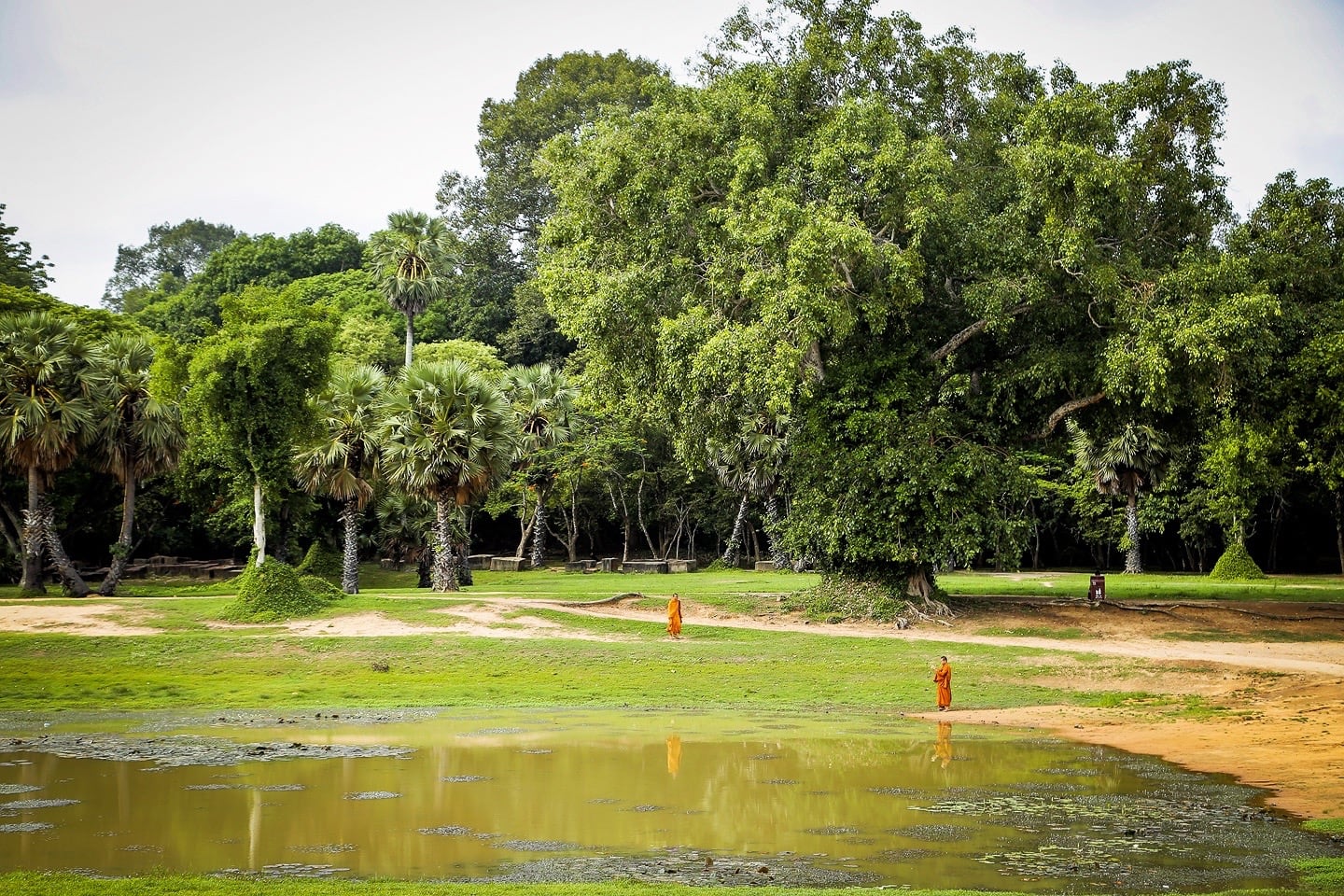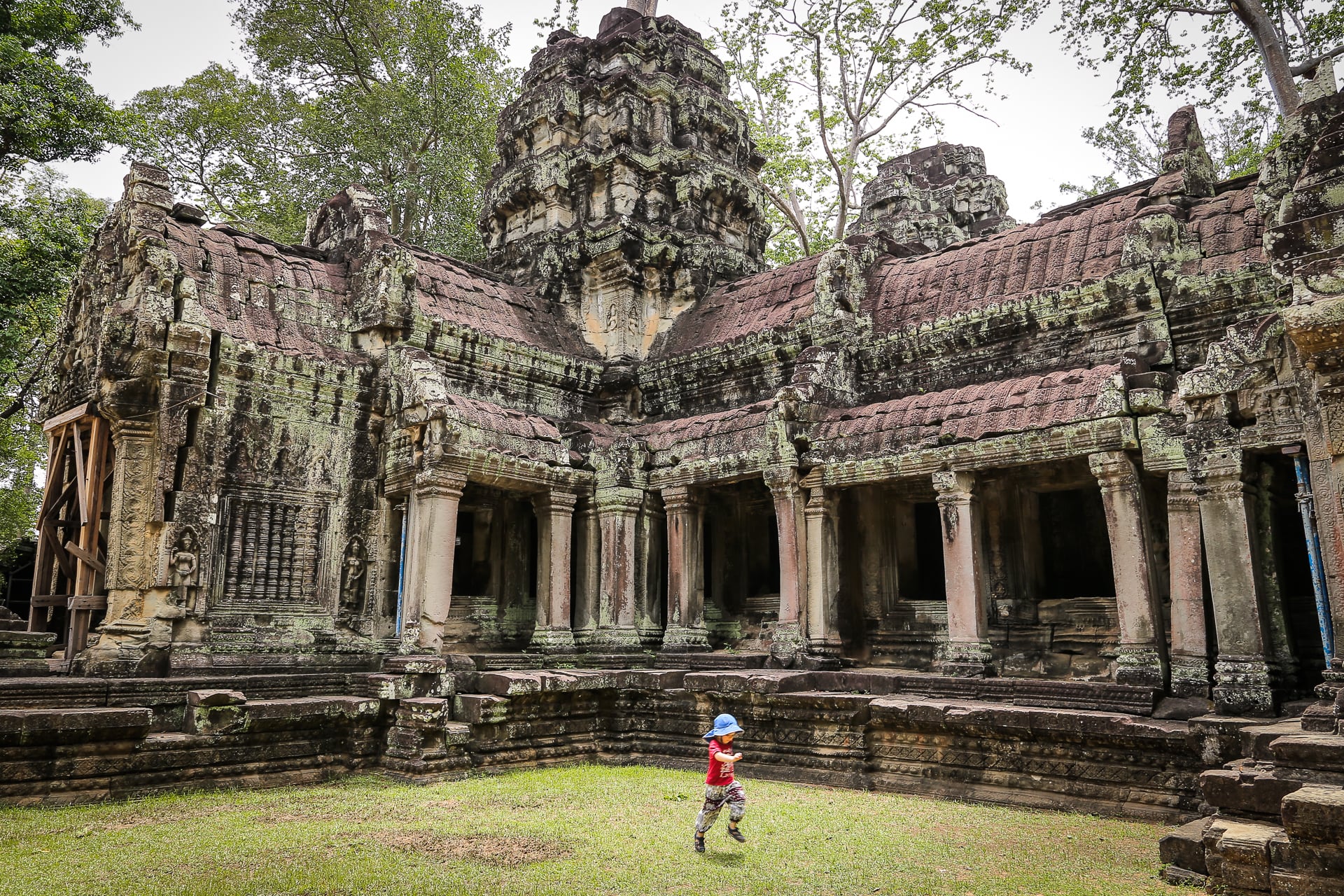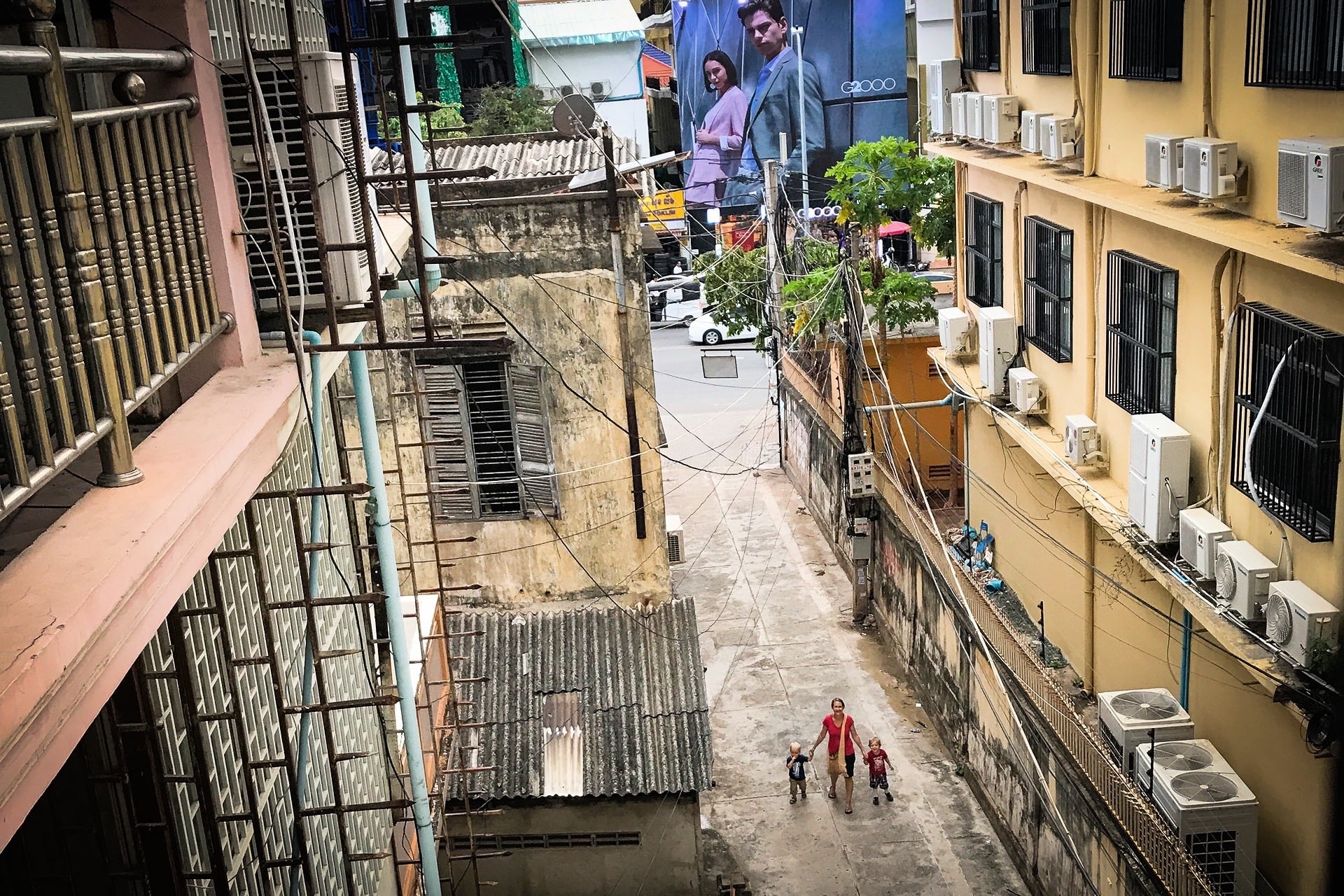When life gives you lemons, sometimes all you can do is make limoncello. Visiting Angkor Wat — one of the most impressive archeological sites on the planet — completely absent of foreign tourists was an opportunity to make the most of a bad situation.
The day after we learned Lori’s role here in Cambodia was being eliminated two years earlier than expected, we decided to pack up the kids later that week and head off to Siem Reap, home to the massive Angkor temple complex.
For more on the situation in Siem Reap during our visit in June 2020, read our previous post.

Visiting Angkor in the Time of Covid
Cambodians Reclaim Their Heritage
Before arriving, we weren’t sure what to expect or just how empty the complex would be.
We’ve been hearing stories from other expats who had visited in April and May that even the most popular and most significant temple, Angkor Wat, was completely deserted.
This seemed hard to believe, mainly because it’s free for Cambodians to enter the archeological park, and Siem Reap (the jumping off point for exploring the site) has a considerable population of about 200,000.
By June, news articles started circulating about how Cambodians had reclaimed their Angkor heritage and were visited in droves, eager to see the temples for themselves in the absence of the two million foreigners that visit the complex each year.
Regardless, we knew that seeing the temples now would be a dramatically different experience than just a few months ago.

Largest Religious Monument in the World
Something worth noting about Angkor for those who aren’t familiar with the site, is that, Angkor is not one temple, but over a thousand structures.
The main temple, Angkor Wat, which appears on the Cambodian flag, is by itself the largest religious monument in the world, encompassing 400 acres.

But the greater Angkor site (ancient City of Angkor) covers 390 square miles and was the largest pre-industrial city in the world.
That’s a lot of area to spread out in for local families, so there’s a good chance that if there are a good number of local visitors today, they won’t all be congregated at the main temple.
This post is wholly devoted to visiting the main temple of Angkor (Angkor Wat).
Future posts will cover a handful of others we also visited over a two day stretch.
Our Previous Visit
Lori and I visited Angkor Wat over three days in 2012 as part of our first overland adventure through Asia. At that time, we aimed to see as much as we could of this vast site with a three-day pass, and largely succeeded in doing so.
On the first day, we hired a remorque (Khmer moto-pulled carriage) to cover what is commonly referred to as the Grand Circuit, encompassing many of the more far flung archeological sites.
On the second day, we rented bicycles, catching the sunrise over Angkor Wat, then proceeding to cover the Petit Circuit of core structures.
On the third day, we hired a remorque and split the day between visiting the stilt village of Kompong Phluk on the Tonle Sap and visiting the Roluos Group of temples.
This is exactly what we’d recommend for first-time visitors to Angkor (post-pandemic, of course), but perhaps swapping out a visit to Kompong Phluk for a visit to Kampong Khleang through the Tonle Sap Experience.
Here in 2020, the goal wasn’t to see everything, but have a fun outing with the kids and soak up the experience. We focused on two full mornings of explorations, visiting Angkor Wat and Ta Prohm on the first morning, and temples in and around Angkor Thom on the second.
The only regret we had from our first visit was the remorque we hired the first day. In short, it was a painful and frustrating experience we wanted to avoid at all costs.
This time around, we reached out to some of our connections in town who were able to recommend an awesome remorque driver who we were very pleased with.

The driver picked us up at 7am at our Airbnb and then it was off to the ticket office to buy our passes.
Here in June, the ticketing authority has been running a promo that amounted to a two-day pass for the price of one day. A one-day pass for foreign passport holders is US$37. The kids were free.

We arrive at the ticket office to find we’re the only ones there. It’s going to be an interesting day…

Despite 20 ticket windows, the lines (and wait times) for buying tickets to Angkor Wat can be excruciatingly long.
Most travel experts recommend buying the tickets the night before, just before closing. The ticket office is a little out of the way so this ensures you don’t waste any time in getting to the temples. Also, getting the tickets the night before is required if you plan on arriving before dawn to watch the sunset.
On this particular day, none of the above applies. We’re the only ones here.

The ladies at the ticket window were very excited to see us and had many questions along the lines of where we were from and how we got here.
I imagine on some level everyone here is just waiting and hoping for any glimmer of hope that things are on the cusp of returning to some sort of normal.
Once we told them we’d come from Phnom Penh where we’ve lived for the past eight months, their smiles quickly turned to knowing nods. Our photos were taken (kids included on mom and dad’s tickets), tickets issued, and we were back on the remorque headed to Angkor Wat.
Our ticket stop took all of five minutes (including a quick toilet stop).

So…Where is Everyone?
In a nutshell, as of writing (14 June), there’s been 128 cases and no deaths. From a health standpoint, Cambodia is weathering the crisis better than most.
From an economic standpoint, it’s a somewhat different story.
The main factor driving tourism has to do with visas and entry restrictions.
ZERO tourist visas have been issued since March.
All other foreigners entering the country (business/ official/ relatives) must present a Covid-free certificate issued within 48 hours and proof of $50,000+ health insurance policy.
Furthermore, all foreigners entering must pay a deposit of US$3,000 per person to cover expenses in case one or more passengers on their flight tests positive for Covid.
All people entering the kingdom are required to quarantine for 14 days in designated housing or self-quarantine if everyone on their flight tests negative.
Suffice it to say, there aren’t a ton of folks at the moment lining up to get into the country solely to visit Angkor Wat.

As we near the main temple of Angkor Wat, the roads are devoid of vehicles, but for a couple dozen bicycles we pass over the course of 15 minutes — presumably all locals enjoying a Sunday out at Angkor.

It appears they’re in the middle of a major renovation to the iconic sandstone causeway leading to the main gate. We’ve been directed to use this floating causeway instead.

Outside the West Gate of Angkor Wat. So far, we’ve seen about half a dozen other visitors.
And yep, both boys are sporting their Laos shirts today. We’re hoping to finally grab them some Cambodia shirts from one of the many hawker stalls around the archeological park.

Passing through the main gate, the gravity of what we are experiencing today really starts to set in.
Angkor Wat. Sunday, 14 June 2020. 8:22 am:

If you’re curious what the scene was like pre-Covid, click here and here.



Angkor Wat in Brief
As mentioned previously, Angkor Wat is the largest religious monument in the world.
It was originally constructed as a Hindu temple in the early 12th century and was later converted to a Buddhist temple towards the end of the 12th century, and has remained a significant center of worship since then.
It was commissioned by the Khmer king as the state temple of the City of Angkor.
Angkor Wat gained UNESCO World Heritage status in 1992 and is one of the most popular archeological attractions in the world.
As a result of the risks posed by over-tourism, in January 2020 (before the pandemic) Angkor Wat was added to the top of Fodor’s annual No-Go list.
Little did Fodor’s know just how steeply Angkor’s tourist numbers would plunge in two-months time, which may prove both good and bad for conservation efforts. A steep drop in tourist numbers over many months equates to less damage to fragile structures, but also less funding for conservation.



Exploring Angkor Wat’s Empty Chambers
With the exception of one or two local families, we had the entire interior of the 900-year-old temple to ourselves.
Absolutely unreal.





Exploring the Bakan Tower
The courtyard surrounding the Bakan central tower is generally the busiest focal point of the temple, due to the limited number of visitors authorities allow to scale the steep stairs to the tower at any given time.
The sign, above, says to allow 15 minutes from this point to reach the stairs (about 30 feet away). Often, line wait times can stretch to an hour on the busiest of days.
Today, however, was a different story. I walked right past the sign, paused briefly to show my ticket, then continued straight on up to the tower.

For a peek of what the Bakan looks like on an average pre-pandemic day, click here.

Kids under 12 aren’t allowed to ascend to Bakan. Lori volunteered to stay behind while I went up.
It was an opportunity I wasn’t going to pass up.

No one up here but me and a monk. And a couple of park rangers to keep the monk and me honest.

The view from the Bakan to the normally packed West Gate lawn.


And…the Bakan central tower, watched over by its faithful, yet likely very bored, park officer.




Lori and the kids resting their feet, below.


Nary a soul in sight.




Final Thoughts
We arrived at Angkor Wat at just after 8 am and were back on the remorque just after 10 am.
Normally, we’d never advocate devoting as little as two hours to seeing Angkor Wat. But for us on this particular day, it felt like a good amount of time.
There were no lines to factor in, we have two toddlers along for the ride, and we’ve toured this amazing place before, albeit a while ago.
The great thing about these ancient places is that they don’t change a lot over the decades. At least, that’s the aim.
Despite managing to stay healthy in the midst of the pandemic, these past three months have been insanely challenging for the four of us on a number of fronts.
But today was one of the good days. A very good day.
To have the rarest of opportunities as a foreigner to wander alone through this ancient, holy place is an experience we are immensely grateful for, and one we won’t soon forget.
Prior to Covid, we were hesitant to actively encourage visitors to Angkor Wat, especially in the wake of its inclusion on multiple endangered and “no-go” lists.
But that all changed, of course, in the blink of an eye.
If you happen to find yourself in a similar boat in Cambodia and the health situation continues to allow for it, a visit to Angkor Wat is certainly worthy of your time, before the selfie-stick toting hordes return.





Your pics are what photography buffs dream of! No one in the way! See as much as you can before you have to leave!
Visited it pre-covid and yes, the crowds were similar to your posted pics of normal times. The queues etc were long and in the heat that can be uncomfortable. Absolutely loved the place and several of the site’s other temples. Enjoy what you have left of your time in Cambodia.
Your words are perfect. “Absolutely unreal.” What an amazing, haunting memory for you all to have, and these photos are going to be a treasure.
Thanks, Allison. Looking forward to reading your guys’ adventures from the road soon!
Love the pictures; I”m not certain I would have been very comfortable there—your pictures gave me an eerie feeling at times!!